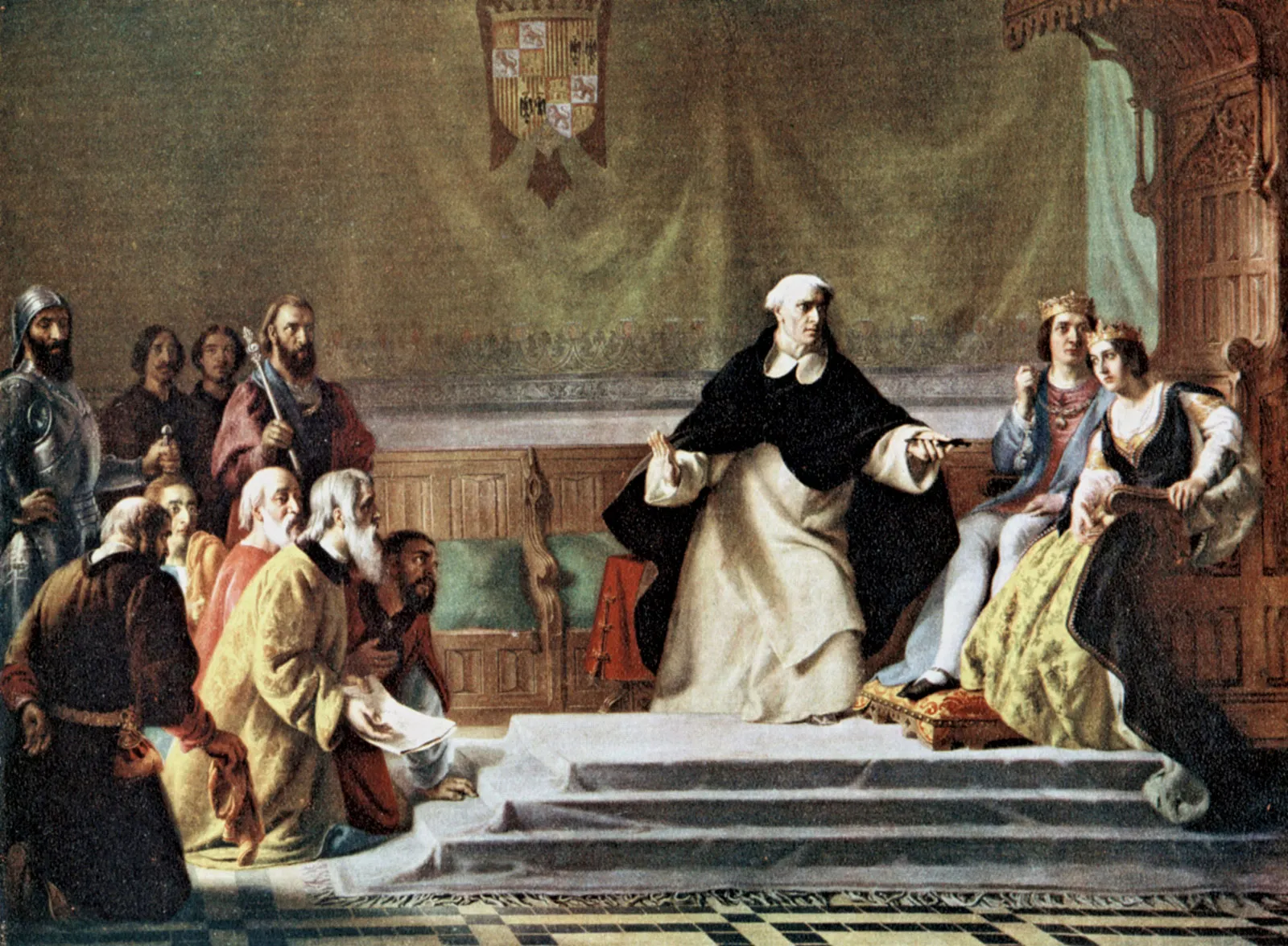
The History of the Spanish Inquisition: Faith, Power, and Persecution
The Spanish Inquisition, a name synonymous with religious persecution and state-sanctioned terror, remains one of history’s most chilling institutions. Established in 1478 by the Catholic Monarchs, Ferdinand II of Aragon and Isabella I of Castile, its stated aim was the preservation of Catholic orthodoxy within their newly unified kingdom. However, its legacy extends far beyond simple doctrinal enforcement. For over three centuries, the Inquisition cast a long shadow across Spain and its vast colonial empire, resulting in the deaths, imprisonment, and exile of countless individuals. This article delves into the complex history of the Spanish Inquisition, exploring its origins in the tumultuous political and religious landscape of 15th-century Spain, its intricate mechanisms of control and oppression, its devastating impact on Spanish society and its colonies, and its enduring legacy on Western conceptions of religious freedom, human rights, and the abuse of power.
The Seeds of Inquisitional Power: A Historical Context
Understanding the Spanish Inquisition requires examining the specific historical circumstances that gave rise to it. Several key factors converged to create the fertile ground for such a ruthless institution:
The Reconquista: The centuries-long Reconquista, the campaign to expel Muslim Moors and Jews from the Iberian Peninsula, concluded just decades before the Inquisition’s establishment. While this period witnessed the unification of Spain under Catholic rule, it also left a legacy of deep-seated religious intolerance and suspicion. Converts to Christianity, known as conversos (from Judaism) and moriscos (from Islam), faced constant scrutiny, with lingering doubts about the sincerity of their conversions fueling widespread anxieties. The Inquisition would become the primary instrument for addressing these anxieties.
Religious Intolerance and the Rise of Heresy: The late 15th and early 16th centuries were a period of intense religious upheaval across Europe. The Protestant Reformation, ignited by Martin Luther’s Ninety-Five Theses in 1517, challenged the authority of the Catholic Church and its established doctrines. While Spain remained staunchly Catholic, the threat of Protestant ideas, along with other forms of perceived heresy, heightened the need for a powerful institution to monitor and suppress dissent.
Royal Power and Political Control: The unification of Spain under Ferdinand and Isabella represented a significant consolidation of royal power. The monarchs saw the Inquisition not only as a tool for religious control but also as a means of strengthening their own authority. By eliminating perceived threats to religious unity, they simultaneously eliminated potential sources of political instability. The Inquisition became intertwined with the state, giving it unprecedented reach and resources.
The Papal Mandate and the Dominican Order: While the Inquisition’s establishment originated with the Spanish monarchs, it received papal authorization from Pope Sixtus IV in 1478. This papal bull legitimized the Inquisition’s activities and granted the monarchs significant autonomy in its operation. Furthermore, the Dominican Order, known for its strict adherence to Catholic doctrine and its experience in combating heresy, played a crucial role in the Inquisition’s structure and administration. The initial Grand Inquisitor, Tomás de Torquemada, was a Dominican friar.
The Structure and Mechanisms of the Inquisition
The Spanish Inquisition was not a haphazard or ad-hoc system of persecution. It was a highly structured and bureaucratic institution with a complex network of officials, informants, and procedures:
The Supreme Council of the Inquisition: This council, based in Madrid, served as the Inquisition’s central governing body. The Grand Inquisitor, appointed by the monarchs, presided over the council, wielding immense authority. The council’s decisions dictated the Inquisition’s overall policies and provided oversight for regional tribunals.
Regional Tribunals: Smaller tribunals were established throughout Spain and its colonies. These tribunals were responsible for investigating suspected heretics, conducting trials, and carrying out sentences. Each tribunal possessed its own staff, including inquisitors, secretaries, notaries, and prison guards. The location and activity of these tribunals varied over time and space depending on the perceived threat of heresy in specific regions.
Informants and Accusations: The Inquisition relied heavily on a network of informants, who were often motivated by personal grievances, religious zeal, or hopes of reward. Accusations, which could be anonymous, were taken seriously and meticulously investigated. The accused had limited means of defense against the power of the state apparatus working in conjunction with the religious establishment.
The Trial Process and the Use of Torture: The inquisitorial process was notoriously unfair, lacking many of the basic protections afforded to defendants in modern legal systems. Accused individuals were often held in secret for extended periods without access to legal counsel. The burden of proof fell on the accused, who were often forced to confess through the use of torture. The use of torture was widespread and brutal, with the rack, thumbscrews, and other instruments of pain employed to extract confessions. Even if the accused initially pleaded innocence, torture was routinely used to induce a confession.
Penances and Punishments: The punishments handed down by the Inquisition ranged from fines and public penance to imprisonment, exile, and execution. Execution, often by burning at the stake, was reserved for the most serious cases of heresy or for individuals deemed particularly dangerous. Those not facing death were typically imprisoned for periods ranging from months to years, with conditions in Inquisition prisons being incredibly harsh. Many faced the confiscation of property, their reputations tarnished beyond repair, and the complete destruction of their families and livelihoods.
The Impact of the Inquisition on Spanish Society and its Colonies
The Spanish Inquisition’s impact on Spain and its colonies was profound and long-lasting. Its effects permeated numerous aspects of social, economic, and cultural life:
The Expulsion of Jews and Muslims: While the Inquisition targeted conversos and moriscos, its actions also contributed to the expulsion of Jewish and Muslim communities from Spain in the late 15th century. The expulsion resulted in a significant loss of intellectual, economic, and cultural vitality for the nation, as many skilled artisans, merchants, and scholars left.
The Suppression of Dissent and Intellectual Freedom: The Inquisition’s power stifled intellectual curiosity and dissent, creating a climate of fear and conformity. Individuals hesitated to express opinions that deviated from official Catholic dogma, leading to a decline in scientific inquiry and a restrictive intellectual environment. The fear of accusation, even on unsubstantiated grounds, permeated all levels of society.
Social Paranoia and Denunciation: The widespread use of informants and anonymous accusations fostered a culture of paranoia and mistrust. Neighbors denounced neighbors, families betrayed each other, and societal cohesion was undermined by fear of the ever-present threat of the Inquisition. This led to societal self-censorship and the suppression of open discussion, critical analysis, and any hint of individual autonomy of thought.
Economic and Demographic Consequences: The Inquisition’s actions had significant economic consequences, not only through the expulsion of Jews and Muslims but also through the confiscation of property and the disruption of trade and commerce caused by the imprisonment and persecution of individuals. The demographic impact was considerable, with countless individuals dying as a result of the Inquisition’s actions, directly or indirectly through illness, starvation, and other hardships.
Colonial Impact in the Americas: The Inquisition’s reach extended to Spain’s vast colonial empire in the Americas, where its activities were similarly brutal and far-reaching. Indigenous populations were subjected to intense religious pressure and persecution, their cultures and traditions forcibly suppressed. The Inquisition was used as a tool to maintain colonial control, reinforce religious conformity, and solidify the dominance of the Spanish crown. Many indigenous peoples had their traditional religious practices brutally eradicated, leading to the destruction of cultural heritage and traditional knowledge.
The Legacy of the Spanish Inquisition
The legacy of the Spanish Inquisition remains a complex and contested topic. While its actions were undeniably horrific, understanding its history provides invaluable insights into the interplay between religious belief, political power, and social control:
A Cautionary Tale of Religious Intolerance: The Spanish Inquisition serves as a stark warning about the dangers of religious intolerance and the abuse of religious authority for political ends. Its history reminds us that unchecked power, even when cloaked in religious justification, can lead to unspeakable atrocities.
The Development of Human Rights and Legal Protections: Ironically, the excesses of the Spanish Inquisition contributed, albeit indirectly, to the development of modern notions of human rights and due process. The abuses committed by the Inquisition highlighted the urgent need for legal safeguards against arbitrary arrest, detention, torture, and unfair trials, helping to shape the later development of more just and equitable legal systems.
The Persistence of Intolerance and Persecution: While the Spanish Inquisition was eventually abolished, its legacy of religious intolerance and persecution has unfortunately persisted throughout history. The Inquisition’s methods and ideology have served as a grim precedent for later instances of state-sponsored religious oppression in various parts of the world. Understanding its historical context is crucial to combating contemporary forms of religious extremism and state-sanctioned violence.
The Importance of Critical Thinking and Historical Awareness: Studying the Spanish Inquisition necessitates a critical examination of historical sources and interpretations. It challenges us to grapple with the complexities of historical events and to avoid simplistic narratives that either glorify or entirely condemn entire institutions. Understanding the Inquisition’s multifaceted nature, rather than resorting to simplistic morality plays, demands a sophisticated engagement with history.
Conclusion:
The Spanish Inquisition represents a dark chapter in human history, a stark reminder of the devastating consequences of unchecked power and religious intolerance. Its impact extended far beyond Spain’s borders, shaping political and social landscapes across Europe and the Americas. While the institution itself no longer exists, its legacy continues to resonate in contemporary debates surrounding religious freedom, human rights, and the dangers of unchecked power. By critically examining its history, we can better understand the forces that led to its creation and the lasting impact of its brutality, ultimately striving towards a more just and tolerant world. The horrors of the Spanish Inquisition serve as a perpetual cautionary tale, a testament to the fragility of human rights and the persistent need for vigilance in safeguarding these fundamental freedoms.


